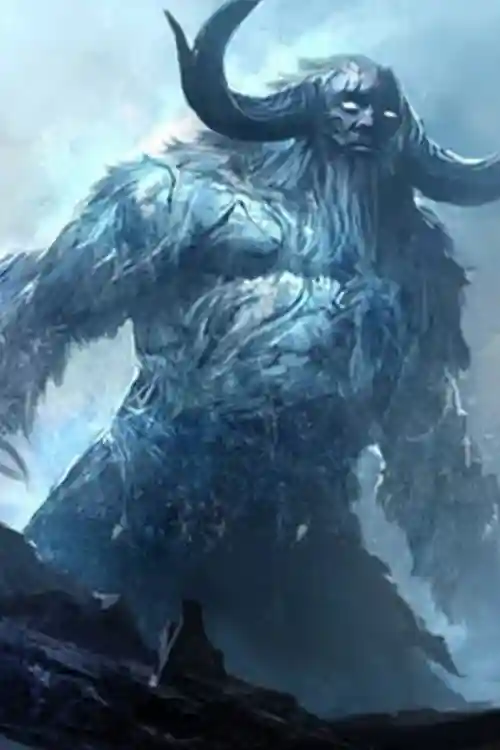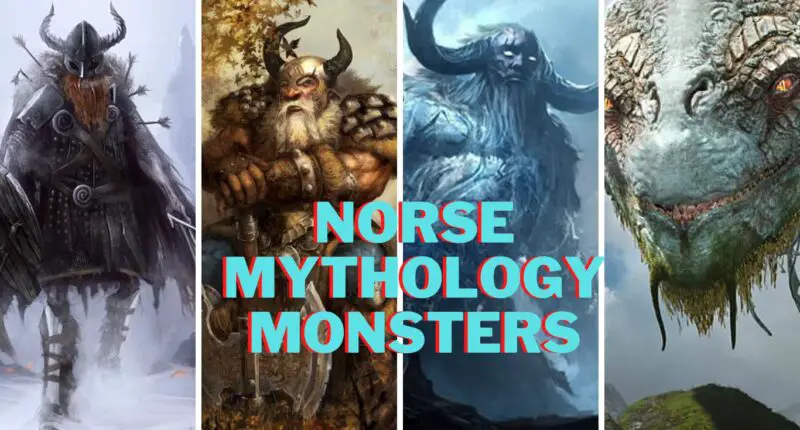Norse mythology features some fascinating figures who are not necessarily mighty gods. Instead, the monsters sporadically show out to terrorize humans and confront the gods. The religious foundation of the Viking warriors that pillaged Europe from the eighth to the eleventh century was Norse mythology, which includes the tales of Odin, Thor, and Loki. Around a thousand years ago, as Christianity spread throughout northern Europe, the religion began to decline. Norse mythology, on the other hand, never wholly lost its hold on Scandinavian thought and has significantly impacted modern literature, television, and video games with its gripping tales, complex characters, and terrible monsters. Here we have talked about top 10 monsters from Norse mythology.
Top 10 Monsters From Norse Mythology
Draugar

In Norse mythology, the dead are known as Draugar. They resemble zombies (monsters) more than vampires, despite the fact that some myths refer to them as blood-drinking creatures. The Draugar can grow bigger at will and have superhuman strength, but they can’t get rid of the smell of death, and they look like dead bodies. The Draugar creature is known to enter communities in order to wreak havoc on the living, frequently punishing people who offended them in life. They frequently live in their graves in order to defend the treasure that they were buried with.
They have the power to crush someone with their superior strength, consume their flesh, consume them whole while enlarged, or kill someone indirectly by making them crazy. These beings were rumored to have the ability to harass the living by entering their dreams, and they would always leave behind a presence to convince the victim that the meeting had actually taken place. People who were nasty, selfish, or unpopular were thought to have the highest likelihood of becoming Draugar after death.
Dwarves

Dwarves, sometimes known as dark elves, are diminutive, deformed beings that appear in both Norse and Germanic mythology. They were born as maggots from the body of Ymir, the first of the Norse giants, and were given the gift of reason by the gods of Asgard. Dwarves were said to reside in Svartalfheim, a subterranean location that was a labyrinth of mines and forges. They were claimed to have created the best jewelry and weaponry, including Mjolnir, Thor’s hammer, Gungnir, Odin’s spear, and the wife of Thor’s long, golden hair. Dwarf beings are sometimes depicted in mythology as turning to stone when exposed to sunlight. For instance, it’s told that one dwarf by the name of Alviss sought to marry Thor’s daughter, but after being duped into chatting until dawn, he was struck by sunlight and turned to stone.
Elves

In Norse mythology, there are two separate kinds of elves: the Dokkalfar, or dark elf monster, and the Ljosalfar, or light elf creature. The dark elves, who live underground and appear to be nearly black in color, are assumed to be identical to dwarfs. On the other hand, light elves were said to be more stunning to behold than the sun. The Vanir god Freyr was the ruler of the elf country of Alfheim, and light elves were frequently compared to the gods of Aesir and Vanir. Elves are typically thought to have conflicting feelings about humans. They had the ability to heal as well as inflict disease on people. It was once believed that occasionally elves and humans interbred to create offspring that looked like humans but had exceptional magical and perceptive abilities.
Fenrir

The most well-known of the many wolves mentioned in Norse mythology was Fenrir. He was the son of the god Loki and the giantess Angrboda. Fenrir was raised by the gods of Asgard to prevent him from wreaking havoc on the nine worlds, but because of how quickly he grew and how much trouble he was causing, they decided to chain him. The gods pretended to be playing a game to test Fenrir’s strength in order to persuade him to let them lock him up. Every tie was easily broken by Fenrir. The gods eventually ordered the dwarves to create a unique chain that was lighter-than-appearing yet stronger than any known chain. In order to demonstrate his good faith, Fenrir insisted that one of the gods put his hand in his mouth while he was being shackled.
Even though he was aware that he would be losing his hand, the deity Tyr agreed to this. Fenrir did indeed take Tyr’s hand after realizing he had been duped. The gods then bound him to a rock and stuck a sword in his mouth to keep it open. Drool from the situation created the foamy river known as Expectation. The foreboding name of the river Expectation appears to be an allusion to Ragnarok, the end of the world in Norse mythology when Fenrir will burst from his bonds and get his retribution. Other huge wolves who follow the sun and moon, Skoll and Hati, are supposed to have been born from Fenrir. Additionally, it is stated that when Ragnarok arrives, they will eventually catch and consume their prey.
Fossegrim

The Fossegrim often referred to as the grim, is a spirit and monster of the sea. With amazing skill, he imitates the sounds of the wind, water, and forest on the fiddle. He can be persuaded to impart the knowledge. He typically requests an offering, such as a white goat thrown northward over a waterfall with its head turned away or four consecutive Thursdays of smoked mutton stolen from the neighbours’ storehouse. The gloomy will only teach the supplicant how to tune the fiddle if there is not enough meat on the bone. He will take the student’s right hand and draw them along the strings until they bleed if the offering is deemed sufficient.
Huldra

The Huldra are guardians of the forest and members of a group of Ra that guards various sites. The female Hydra is invariably depicted as being stunningly attractive and sensual, but with a cow-like tail and a back covered in bark. To navigate the world of men, the Huldra can pass for young ladies. They can only lose their illusion if someone notices their tail. Young, single males are lured into the forest by the Huldra when they visit communities in order to serve as slaves, and lovers, or occasionally to drain their life force. If one of their victims is freed or manages to escape, they will never again feel the want to go back to their captor.
Jormungandr

Another offspring of Loki and Angrboda, the Jormungandr is also referred to as the Midgard Serpent. He inhabits the sea that envelops Midgard, the realm of the visible human race, like a snake or dragon. He was allegedly thrown into the water by Odin to keep him out of danger. However, this beast grew to such a size that he was able to encircle Midgard as a whole and grab hold of his own tail. He is said to be Thor’s adversary.
In one tale, Thor was out on the water with the giant Hymir, catching whales in Hymir’s favorite fishing sites, but Thor insisted on going out to sea, where he hooked Jormungandr. Jormungandr is dribbling poison and blood when they meet face to face as he pulls the serpent out of the sea. Before Thor can slay the serpent with his hammer and return it to the sea, Hymir, who is horrified by the scene, cuts the fishing line. The serpent will emerge from the sea and poison the ocean during Ragnarok, according to another legend, and Thor and Jormungandr are destined to kill one another then.
Jotnar

The giants known as Jotnar in Norse mythology are said to possess abilities comparable to those of the gods. The name Jotnar, which does not allude to their size, means “devourers”. The Asgardian gods represent order, and the Jotnar embody chaos, making them the enemies of the gods. Nevertheless, the Jotnar are the ancestors of many Asgardian deities. Thor is three-quarters Jotnar, and Odin is half Jotnar. The Asgardian gods want to control the Jotnar rather than kill them in order to maintain the equilibrium of the world. The Norse creation myth, in which the gods create the universe from the dead body of the slain Jotnar Ymir, reflects the significance of balance in the cosmos.
Kraken

If men were drawn to the island, it would sink when they set foot on it, killing them and leaving them as food for the Kraken. When it rose to the surface it was believed to cause large whirlpools which would help it attack ships. The men were attracted to the island, they would perish when they stepped foot on it as the Kraken would use them as food. It was thought that when it surfaced, it would create huge whirlpools that would aid in its ability to assault ships. The Kraken primarily consumed fish. By discharging their bowels into the water, they would entice fish to them. Their waste was so substantial and intensely fishy smelling that the Kraken would be attracted to the region by the influx of additional fish.
Mare

The Mare monster would sit on individuals while they slept at night, giving them horrible dreams. The Mare was thought to be the souls of living individuals who, like demons, departed from their bodies at night. These were frequently witches, whose souls assumed animal forms, but it was also believed that normal humans, especially teenagers, may transform into Mare when their spirits wandered. It was a popular belief that the spirit wandered at night. Odin was concerned that one day his spirit could leave his body because it left so frequently. Additionally, it was said that whenever the Mare came into contact with a live creature, such as a person, a cow, or a tree, their hair would become tangled. This was most likely used to explain the Polish plait phenomenon, a hair condition. It was also alleged to be the cause of some trees’ branches and roots intertwining.
Also Read: Asgard: Everything you need to know about Asgard from Norse mythology



